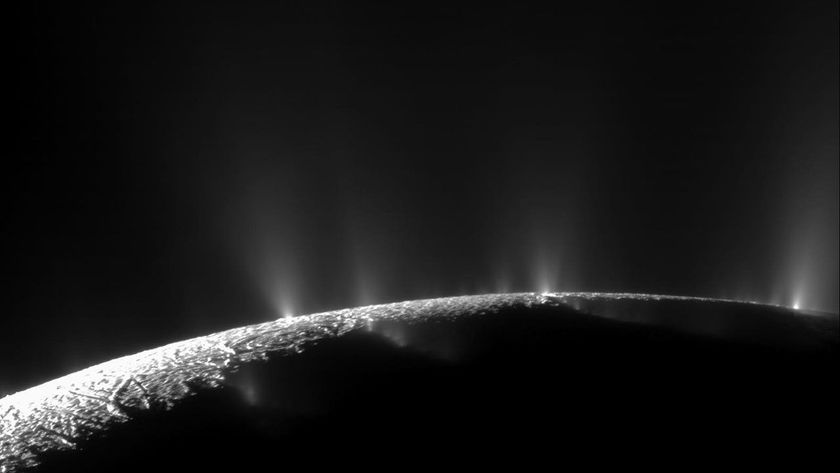Mystery of Saturn's Watery Moon Solved
Cosmic sprinklers that spurt misty jets from cracks along Saturn's sixth largest moon could hint at a vast watery lake hidden beneath the icy shell of Enceladus.
In 2005, NASA's Cassini spacecraft revealed giant geysers of ice grains and water vapor shooting from the south pole of Enceladus. But how the geysers formed and the source of the ice crystals had remained a mystery until now. New research, detailed in the Feb. 7 issue of the journal Nature, provides a clear view of the processes beneath the moon's crust that yield the handful of geysers.
The results reveal there must be water beneath the moon's surface and also support the idea that Enceladus' geysers are the source of Saturn's E-ring, a faint circle of tiny ice and dust particles.
"Since Cassini discovered the water vapor geysers, we've all wondered where this water vapor and ice are coming from," said researcher Juergen Schmidt of the University of Potsdam, Germany, who is a team member on Cassini's Cosmic Dust Analyzer. "Now, after looking at data from multiple instruments, we can say there probably is water beneath the surface of Enceladus."
The researchers are uncertain how large the water reservoir is. "It might be a global ocean. It might be just a small lake," Schmidt said.
The finding makes Enceladus one of only four moons in our solar system thought to harbor liquid water. The other watery worlds are Jupiter's moons Europa, Ganymede and Callisto. While Saturn is home to 60 identified moons, Enceladus is the first to show signs of liquid water.
Beneath the ice
Sign up for the Live Science daily newsletter now
Get the world’s most fascinating discoveries delivered straight to your inbox.
Schmidt and his colleagues relied on Cassini data on the ice grains along with computer models to arrive at their conclusion about the water.
Here's what they think is happening:
Hidden beneath Enceladus' icy exterior is a lake with a temperature of about 32 degrees Fahrenheit (0 degrees Celsius). At these relatively warm temperatures (for the frigid outer solar system) liquid water, ice and water vapor mingle. The vapor moves upward through channels in the ice toward openings at the moon's surface. Upon reaching the vacuum conditions of space found within the channels and cracks, the vapor expands and cools leading to the formation of ice crystals.
Both the model and the Cassini observations suggest the vapor in the plumes moves at roughly the same speed as a supersonic jet, about 650 to 1,100 mph (300 to 500 meters per second). That's nearly double the speed needed to escape Enceladus' gravity.
The ice grains, however, trek along at a much slower rate. The researchers say as the ice particles zigzag through crooked cracks in the ice, they ricochet off the walls and lose speed. The water vapor moves unimpeded through the crevasses and boosts the frozen particles to carry them upward.
Even with a push from the vapor stream, only about 10 percent of the ice particles have enough energy to break through Enceladus' gravity. The remaining slowpokes fall back to the moon's surface.
Saturn's ring
The escaped ice crystals' liberty is short-lived, however. Scientists think the crystals are recaptured by Saturn's gravity and coalesce to form the planet's E-ring.
"These particles in the E-ring hit other satellites in the system or the main rings of Saturn or they hit Enceladus itself," Schmidt told SPACE.com. "So they are born at Enceladus, but they also have sinks so they die somewhere, and that gives them balance which is more or less steady today."
The heat source that drives the interior melting of the ice is still unknown, but now researchers think they know the conditions needed to drive Enceladus' plumes.
"If vapor temperature is too low, then the gas density is too small to push the grains out and we would not see such large amounts of particles," Schmidt said. "Therefore, we believe that at the site of evaporation, we must have temperatures near the melting point of water."
The next Enceladus flyby is set for March, when the Cassini spacecraft will reach its closest approach of a mere 30 miles (50 kilometers) from the surface. As the spacecraft moves farther away to an altitude of about 124 miles (200 kilometers), it will pass through and sample Enceladus' plumes.
Jeanna Bryner is managing editor of Scientific American. Previously she was editor in chief of Live Science and, prior to that, an editor at Scholastic's Science World magazine. Bryner has an English degree from Salisbury University, a master's degree in biogeochemistry and environmental sciences from the University of Maryland and a graduate science journalism degree from New York University. She has worked as a biologist in Florida, where she monitored wetlands and did field surveys for endangered species, including the gorgeous Florida Scrub Jay. She also received an ocean sciences journalism fellowship from the Woods Hole Oceanographic Institution. She is a firm believer that science is for everyone and that just about everything can be viewed through the lens of science.












